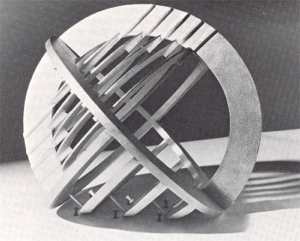The Aotea Square Water Sculpture
PAUL LITTLE
In 1978 the Auckland Savings Bank donated $75,000 to the city of Auckland for the purpose of erecting a sculpture in Auckland's Aotea Square. The only condition placed on the gift was that the sculpture should feature moving water.In contrast to Auckland's flatly inhuman Downtown Square, bound on all sides by light-obliterating 'skyscrapers', Aotea Square (though just as barren) is open enough to suggest some expansion of human activity. Unlike the disastrous siting of Mitio Ihara's wind sculpture in the former location, Aotea Square will at least allow a sculpture to be seen.

Terry Stringer's maquette
of his prize-winning sculpture
The council voted to hold a competition to select a work for the site. A panel made up of Sir Dove-Myer Robinson, Ms Catherine Tizard, Mr Brenton Rule (of the Auckland Savings Bank), Professor Peter Bartlett (of the Auckland University School of Architecture) and Mr Greer Twiss. Forty-two applications were received from around the country and the panel invited fourteen of these to submit further information and examples of previous work.
Six of these sculptors - Tanya Ashken, Chris Booth, Steven Furlonger, Peter Nicholls, Terry Stringer and Marte Szirmay - comprised the short-list which was asked to prepare maquettes, along with drawings and written material. From these the panel chose Terry Stringer as the eventual winner of the competition. Interestingly enough, only Greer Twiss considered the selection of a figurative sculpture might be more controversial than that of an abstract one.

Marte Szirmay's maquette
of a water sculpture for
Aotea Square
To be fabricated in sheet bronze, the winning design makes use of features familiar from Stringer's earlier work. It is a water sculpture and represents, by means of two interlocking pyramids (interrupted at points by triangular cutouts), a rocky, mountainous outcrop down three walls of which foaming water flows (foaming, due to the rough surface over which it will run). The work also features valleys that are tilted and paved to give a false perspective of depth. The emphasis on triangular geometry, sharp edges and sudden changes in line relates the sculpture to the buildings around the square as well as making it unique among Auckland's sculptural fountains.
While the architecture of the work is definitely urban, its subject provides a spectacle of the New Zealand landscape that will contrast sharply with the viewers' surroundings. At the foot of one of the falls is the figure of a girl. When the water is playing, she will appear to fall into it with a splash; when it is shut off she will float above a pool, reflected in its surface.

Chris Booth's entry
in the Aotea Square competition
Stringer says he is glad of the opportunity to create a work which will have a wide audience and which relates to the environment on a large scale. He has kept his audience firmly in mind. A lake represented on the top of the sculpture is visible only from a high vantage point (of which there are many around the square) and the balance between natural form and simple geometry creates one further element of aesthetic interest. From a distance the sculpture is an intriguing abstract shape: close-up it becomes a mountain.
